There are many edible orange mushrooms. Throughout this article, I explain how to identify edible orange mushrooms. You will find high-quality photographs to identify the edible orange mushrooms correctly. In addition, at the end of this post, you will find a video to recognize even easier edible orange mushrooms.
Generally, edible orange mushrooms appear in gardens and forests from summer to late autumn. Different climatic factors, such as rainfall and temperatures, may vary slightly when orange mushrooms appear. It is essential to identify them correctly because there are toxic orange mushroom varieties.
Table of Contents
Wild Edible Orange Mushrooms Video
Here is a video to help you identify wild edible orange mushrooms more easily.
Are Orange Mushrooms Edible
Are orange mushrooms edible? Several edible orange mushrooms are considered safe for consumption. The edibility of orange mushrooms is not consistent across all species. Some orange mushrooms are edible and safe for consumption, while others can be toxic or deadly. It’s vital to accurately determine the exact orange mushroom type before eating them.
In this article, I will explain which are the most common orange edible mushrooms. These mushrooms are the most easily found in the forest, some are very easy to identify, and others are more difficult. I encourage you to take a good look at the pictures. Then I strongly recommend you watch the video to recognize the edible orange mushrooms correctly.
Edible Orange Mushrooms
As mentioned above, there are many edible species of orange mushrooms. Remember that accurate identification is crucial when it comes to mushrooms.
If you are new to foraging, I recommend starting with well-known edible species and learning from experienced foragers or mycologists before consuming any wild mushrooms, including orange ones.
Let’s see six orange edible mushrooms you may find attached to trees and pieces of wood:
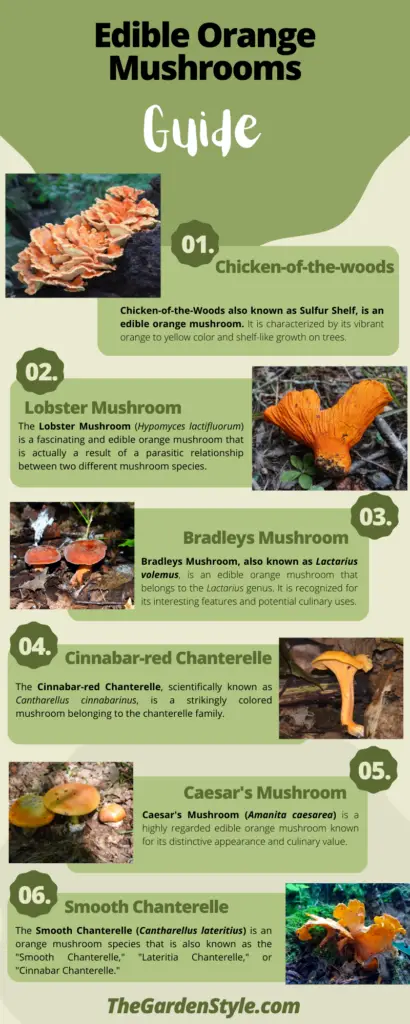
Chicken of the Woods (Laetiporus sulphureus)
Chicken of the Woods, also known as Sulfur Shelf, is an edible orange mushroom. It is characterized by its vibrant orange to yellow color and shelf-like growth on trees. The caps of Chicken of the Woods range from bright orange to yellow, with a soft, slightly fuzzy texture.
This mushroom typically grows in overlapping clusters or shelves on trees, stumps, or logs. The caps can vary in size, often ranging from a few inches to over a foot in diameter. Instead of traditional gills, Chicken-of-the-Woods has a porous underside with tiny pores that release spores.
Chicken of the Woods can be found on live or dead trees, particularly oak trees and other hardwoods. It appears during late spring to early autumn, depending on local environmental conditions and geographical location.
Learn more about Sulfur Shelf Mushroom by following the link
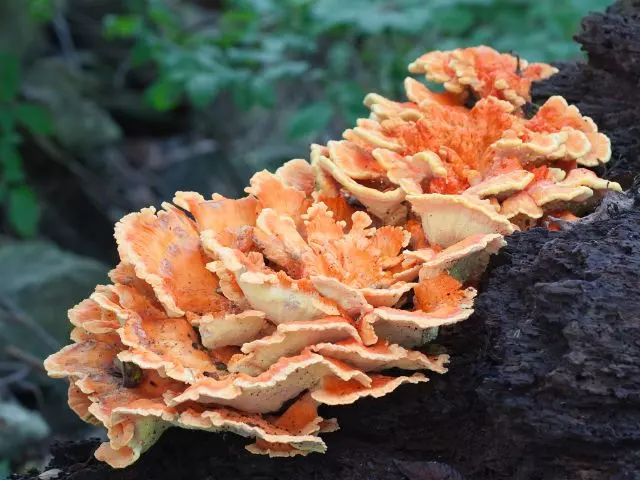
Lobster Mushroom (Hypomyces lactifluorum)
The Lobster Mushroom (Hypomyces lactifluorum) is a fascinating and edible orange mushroom resulting from a parasitic relationship between two different mushroom species. The parasitic fungus enters the host mushroom, altering its look and feel. This process brings the vibrant orange hue and a shape reminiscent of a lobster.
The Lobster Mushroom is considered edible and appreciated for its unique flavor, which some describe as seafood-like, similar to lobster or crab. Use this delicious edible orange in various dishes, such as stir-fries, soups, and sauces.
The mature Lobster Mushroom has a vibrant orange to red-orange color and a firm, seafood-like texture. It often develops a folded and contorted appearance, resembling a cooked lobster shell.
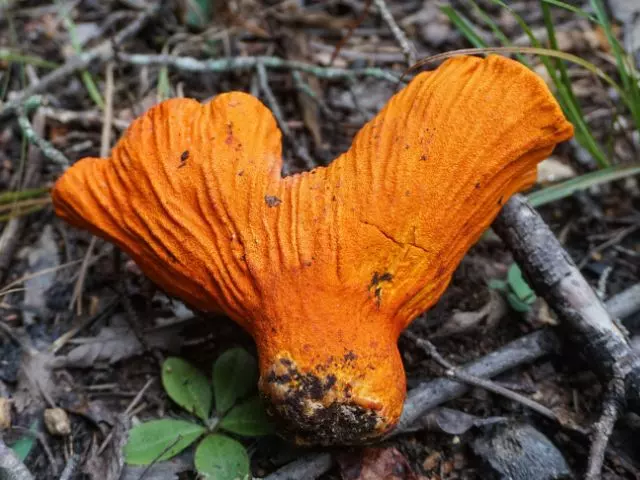
Bradleys Mushroom (Lactarius volemus)
Bradleys Mushroom, also known as Lactarius volemus, is an edible orange mushroom that belongs to the Lactarius genus. It has exciting features and potential culinary uses. The cap of Bradleys Mushroom is convex to flat, with a central depression. It often has concentric rings and a wavy margin. The cap’s color can range from orange-brown to tan.
The gills are crowded and attached to the stem. When damaged, they can release white latex, a characteristic feature of the Lactarius genus that turns yellow upon air exposure.
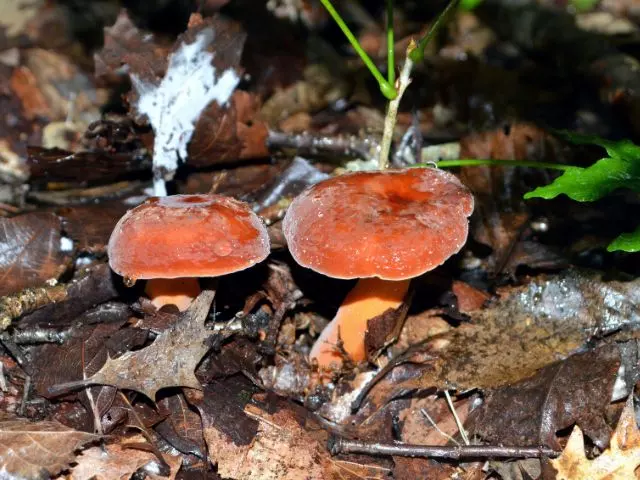
Cinnabar-red Chanterelle (Cantharellus cinnabarinus)
The Cinnabar-red Chanterelle, scientifically known as Cantharellus cinnabarinus, is a strikingly colored mushroom belonging to the Cantharellaceae family. The cap of the Cinnabar-red Chanterelle is a vibrant red-orange mushroom, resembling the shade of cinnabar, a mineral. It often has a wavy or slightly irregular shape.
These ridges extend from the edge of the cap down the stem and have a fork-like appearance. The stem is typically a similar color to the cap and may be cylindrical or slightly widened at the base.
It tends to grow on the ground near trees and other vegetation. The Cinnabar-red Chanterelle is edible and consumed by foragers familiar with its characteristics.
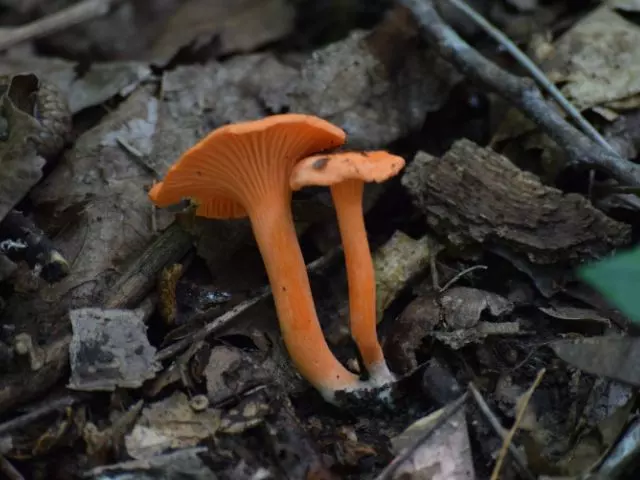
Caesar’s Mushroom (Amanita caesarea)
Caesar’s Mushroom (Amanita caesarea) is a highly regarded edible orange mushroom known for its distinctive appearance and culinary value. The cap of Caesar’s Mushroom is bright orange to reddish-orange, and it is usually smooth and convex when young, later flattening out.
The gills are white and free from the stem, not attached. However, it is worth noting that the partial veil covers the gills when the Mushroom is in its immature “egg” stage. The stem is pale, often with a slightly swollen base, and features a movable ring. Caesar’s Mushroom has a delicate and slightly nutty flavor. Prepare in various ways, such as sautéing, grilling, or incorporating it into pasta dishes.
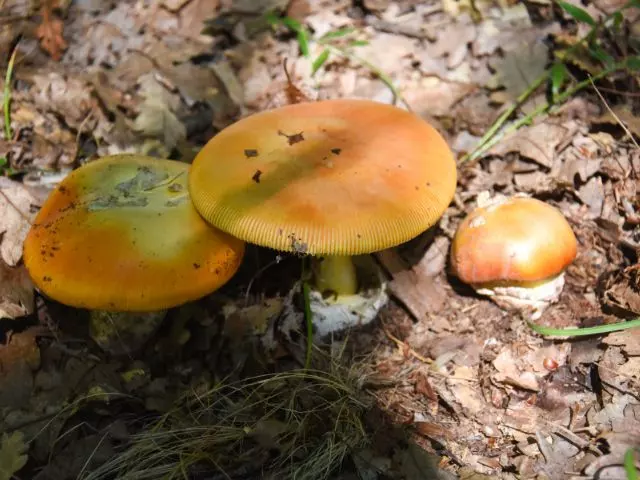
Smooth Chanterelle (Cantharellus lateritius)
The Smooth Chanterelle (Cantharellus lateritius) is an orange mushroom species that is also known as the “Smooth Chanterelle,” “Lateritia Chanterelle,” or “Cinnabar Chanterelle.” You may find the Smooth Chanterelle mushroom in types of forests, including hardwood and mixed-wood forests.
The cap of the Smooth Chanterelle mushroom can range from reddish-orange to more subdued brownish-orange. It often has a smooth or slightly wrinkled texture. Unlike traditional gilled mushrooms, chanterelles have ridges instead of true gills. These ridges run down the stem and have a distinctive, fork-like appearance. The stem of the Smooth Chanterelle is usually a similar color to the cap and may be slightly lighter or darker.
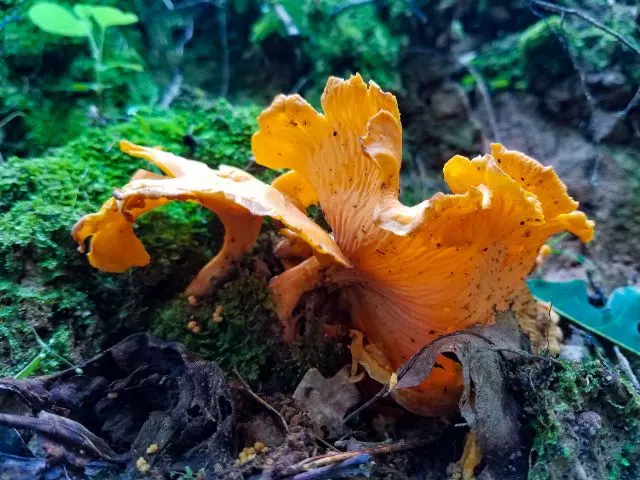
Final Conclusions About Orange Edible Mushrooms
Let’s see some final thoughts regarding orange edible mushrooms and their taste.
Who hasn’t ever found orange mushrooms in the yard or the forest? And then you may have wondered how safe they are, whether they are poisonous or edible, especially after seeing the large structures they can form attached to trees and pieces of wood.
Although many mushrooms found in nature are toxic, it is interesting to take advantage of edible resources such as orange mushrooms that can give our recipes a gourmet twist.
From the captivating Chicken of the Woods to the delicate and nutty Bradleys Mushroom, the orange mushroom world boasts diverse culinary delights. Each Mushroom has its own story, a unique taste to savor, and a connection to its home environment.
I hope you can correctly identify edible orange mushrooms with all the details provided in this article. I also recommend you look for a mycology club in your area to know even better the orange mushrooms that grow there.
Disclaimer: The information contained in this guide is intended for general informational purposes only. It is not a substitute for professional advice or guidance. Always consult a knowledgeable mycologist or experienced forager before consuming any wild mushrooms, including orange ones.

